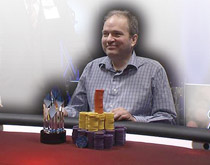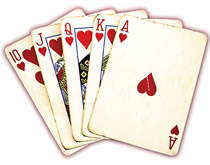 The cameras are rolling on “Poker Night in America,” a television show that broadcasts high-stakes tournaments from premier venues across the country. Larry Pileggi (E’89), a CMU professor, is at the table, giving the “faculty member stare down” to his opponents, many of whom are professional players. Not Pileggi. Three years ago, he thought he’d try the game, so he read 20 books on the subject and dove in.
The cameras are rolling on “Poker Night in America,” a television show that broadcasts high-stakes tournaments from premier venues across the country. Larry Pileggi (E’89), a CMU professor, is at the table, giving the “faculty member stare down” to his opponents, many of whom are professional players. Not Pileggi. Three years ago, he thought he’d try the game, so he read 20 books on the subject and dove in.
“That’s how we do everything,” he says. “We” refers to all of his colleagues in the electrical and computer engineering department, who, he says, believe that if you climb a mountain, you climb the highest one. If you’re going to play poker, then you don’t just play with your buddies—which is why Pileggi bought into a game of Texas Hold ’Em for $1,000 in the Pittsburgh’s Rivers
Casino Championship being filmed by
“Poker Night in America.”
 The winner will be the player who ends up with all of the chips. Round one lasts 11 hours and winnows the pack of hopefuls from 300 to 88. The second day, Pileggi returns to the set, where he watches his chips dwindle 65%. Undaunted, he keeps playing hands in a game that he calls a “combination of math, psychology, and physiology.”
The winner will be the player who ends up with all of the chips. Round one lasts 11 hours and winnows the pack of hopefuls from 300 to 88. The second day, Pileggi returns to the set, where he watches his chips dwindle 65%. Undaunted, he keeps playing hands in a game that he calls a “combination of math, psychology, and physiology.”
By 4:30am, he’s amassed 3 million of the 8 million chips in play. On just two hours of sleep, he’s back at the casino for the final showdown among the remaining six players. He studies the veins in their necks (they pulse noticeably when a player is nervous); he studies the pupils (they dilate when a player might be bluffing). But most of all, he studies the cards.
An hour goes by. Two hours. And then, the winning hand. Pileggi’s pairs of eights and fives beat his opponent’s pair of queens. He goes home with first prize: $71,782.



